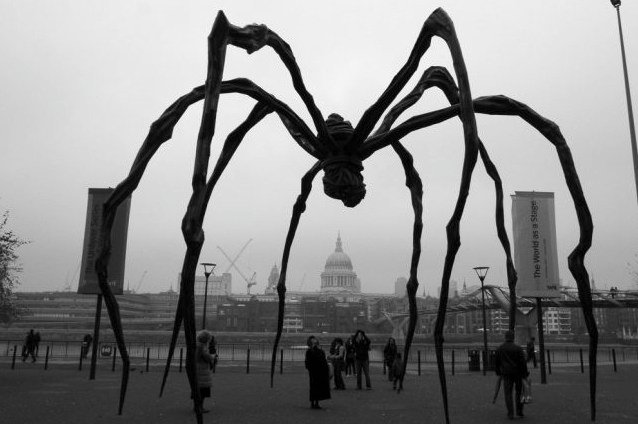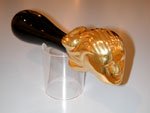Louise Bourgeois BIOGRAPHY

Early Life and Background
Louise Bourgeois was born on December 25, 1911, in Paris, France. She was the second of three children born to Joséphine Fauriaux and Louis Bourgeois. Her parents ran a tapestry restoration business, which had a profound influence on her artistic sensibilities.
Growing up surrounded by fabrics, threads, and needlework, Bourgeois developed an early appreciation for the tactile and visual aspects of art.
Tragedy and Emotional Turmoil
Bourgeois’s early life was marked by tragedy and emotional turmoil, which had a lasting impact on her art.
When she was just 21 years old, her mother passed away, an event that deeply affected her and contributed to the themes of loss, abandonment, and motherhood that would later become prevalent in her work.
Education and Early Artistic Endeavors
In pursuit of her passion for art, Bourgeois studied mathematics at the Sorbonne in Paris before enrolling at the École des Beaux-Arts and Académie Julian. She also briefly studied art at the Atelier Fernand Léger.
During her formative years, she became acquainted with various artistic movements, including Surrealism and Cubism, which influenced her early works.
Move to the United States
In 1938, Bourgeois married American art historian Robert Goldwater and moved to New York City, USA, where she would spend most of her life.
New York’s vibrant art scene allowed her to engage with emerging Abstract Expressionists like Willem de Kooning, Mark Rothko, and Jackson Pollock. While these artists were predominantly male, Bourgeois managed to carve her own artistic path.
What is Louise Bourgeois known for?

Louise Bourgeois was a renowned French-American artist known for her influential contributions to modern and contemporary art, particularly in sculpture and installation.
Career highlights

What is Louise Bourgeois’s Style?
Louise Bourgeois’s art was deeply introspective and often drew from her own emotional experiences. She explored themes of sexuality, femininity, motherhood, and the human condition.
Here is some of her work:
- Femme Maison (1946–47):
In this series of paintings, Bourgeois explores the relationship between women and the concept of home. She replaces women’s heads with houses, symbolizing their isolation from the outside world and confinement to domestic roles. These artworks reflect the dehumanization often seen in modern art.
- Destruction of the Father (1974):
A deeply psychological and biographical exploration of the dominance of fathers and their offspring. The installation features flesh-toned materials in a soft, womb-like room. The abstract children of an overbearing father rebel, murder, and consume him. It’s a powerful representation of the artist’s emotions and experiences.
- Exorcism in Art (1982):
Bourgeois’ artistic journey involved a relentless attempt to purge her emotional unrest. Her mixed media works on paper, metal, marble, and animal skeletal bones allowed her to explore female identity, body issues, and family dynamics. Her art delved into themes ahead of its time, showing tenderness, violence, acceptance, and defiance.
- Cells:
Produced in her eighties, the “Cells” are enclosed installation works representing psychological and intellectual states, mainly fear and pain. Viewers are invited to peer inward at symbolic objects or enter small rooms.
Bourgeois uses personal items charged with emotional significance, turning the cells into powerful expressions of her experiences.
- Maman:
In the late 1990s, Bourgeois incorporated the spider as a central motif in her art. “Maman,” her most iconic spider sculpture, stands over 30 feet tall and has been installed in various locations worldwide.
The sculpture pays homage to her mother, who was a weaver and a nurturing, protective figure. Spiders, like her mother, are seen as friendly and helpful beings.
- Maisons fragiles / Empty Houses:
These parallel, metallic structures supporting simple trays evoke deep anxiety. Bourgeois’s traumatic childhood may have influenced the creation of these artworks, as they reflect the psychological impact of vulnerable, narrow houses without a solid base.
Artistic Evolution
Bourgeois’s artistic career spanned several decades, and she continuously evolved as an artist. Her early works were often figurative and organic, transitioning to more abstract and conceptual pieces over time.
She experimented with various materials, including wood, bronze, fabric, and marble, to give form to her creative vision.
Louise Bourgeois List of Work

Notable Exhibitions and Site-Specific Projects
Louise Bourgeois’ profound impact on art extends beyond traditional museum exhibitions. Her artwork has been prominently featured in site-specific installations across the globe, enriching public spaces with her powerful creations.
- Massachusetts Museum of Contemporary Art (MASS MoCA)
For nearly a decade, MASS MoCA in North Adams, Massachusetts, has been home to a remarkable collection of Bourgeois’ pieces, showcasing her sculptures in marble and various other materials.
The museum provides a unique and immersive experience, allowing visitors to engage closely with her art and delve into the emotional depth of her work.
- Maman’s Multi-City Tour
One of her most iconic sculptures, “Maman,” has been featured in a multi-city tour, reaching diverse institutions and public areas.
This tour allowed audiences worldwide to encounter the awe-inspiring presence of the monumental spider sculpture.
- Pérez Art Museum Miami (PAMM) Exhibition
In 2020, a significant group exhibition titled “My Body, My Rules” at PAMM in Florida featured Bourgeois’ works among those of 23 other female-identified artists.
Louise Bourgeois’ presence in this exhibition, alongside other influential artists like Carolee Schneemann, Cindy Sherman, Lorna Simpson, and others, further solidified her legacy as a trailblazer in the art world.
Legacy and Influence
Louise Bourgeois’s art continues to resonate with audiences worldwide. Her willingness to explore vulnerability, personal traumas, and taboo subjects made her work both provocative and emotionally powerful.
She paved the way for future generations of female artists and remains an inspiration to many contemporary creators.
Passing and Posthumous Celebrations
On May 31, 2010, Louise Bourgeois passed away in New York City at the age of 98. In the years following her death, her artistic legacy has been celebrated with major exhibitions and retrospectives at prestigious institutions.
Her artworks are displayed in prominent museums, galleries, and public spaces, ensuring that her impact on the art world endures for generations to come.
More about Louise Bourgeois
Louise Bourgeois Foundation
The Easton Foundation, established by Louise Bourgeois in the 1980s, is a non-profit and charitable organization. The Foundation’s primary mission is to promote the scholarship and awareness of Bourgeois’s life and art.
The foundation offers a unique opportunity to experience the artist’s world firsthand through guided tours of her home, studio, archive, and sculpture garden.
Visitors can immerse themselves in the creative space where Bourgeois produced her iconic works and gain insights into her artistic process.
For more information, visit its official website:
http://www.theeastonfoundation.org/foundation







